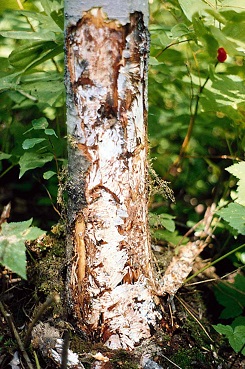Tree root disease biology
A tree root disease starts in the roots and remains in the roots and lower stem of its host tree. Susceptibility to a root disease varies by tree age, genetics, type of root disease pathogen and site history.
On this page
Host susceptibility and symptoms
Trees of all ages can be affected by root disease. Learn more about root diseases and relative host susceptibility (GIF, 6.5KB).
Disease is mostly detected when a stand, or a specific tree is studied. Air photos and satellite imagery can help find root disease.
For detailed information about field identification of all major root diseases in B.C., see the Field Guide to Forest Damage in British Columbia (PDF, 6.5MB).
Distribution maps
These maps show where, in B.C., diseases occur:
- Armillaria root disease map (PDF, 523KB)
- Laminated root rot map (PDF, 529KB)
- Tomentosus root rot map (PDF, 483KB)
- Blackstain root disease map (Douglas-fir variety) (PDF, 522KB)
- Blackstain root disease map (pine variety) (PDF, 531KB)
- Annosus root disease map (PDF, 529KB)
Stand dynamics
In forest stands a root disease will kill trees either singly or in patches known as disease centers. These disease centers will continue to grow in size as the disease spreads outward. The root disease fungi can remain in dead roots and soils for many years. Over time the centers are occupied by plants and trees that are not susceptible to the root disease and thus the root disease slowly dies out.
Forestry practices
Harvesting trees or manipulating the stand can lead to a dramatic increase in the amount of root disease. On the other hand, treatments that establish and maintain disease tolerant, site-suited tree species can reduce losses.
Biological principles for foresters
If you're a forester creating prescriptions be aware of these biological principles:
- Root disease inoculum (mainly stumps) remains infectious for up to 35 years, depending on fungal species and inoculum size
- Root disease incidence increases with increasing host susceptibility and increasing proportion of susceptible species
- Root disease incidence and damage may accumulate over time without appropriate treatment
- Root diseases infect trees and subsequently spread from tree to tree via root contacts or grafts, spores, and in the case of Armillaria, by rhizomorphs
- Armillaria root disease may rapidly spread throughout a stump when quiescent root lesions are triggered by brushing, thinning, or partial cut harvesting
- Root diseases may infect healthy hosts after contact with inoculum on or in stumps and root material remaining in the soil after fire, windthrow, harvesting, or thinning
Unexposed, residual inoculum has an infective lifespan of up to 35 years, meaning that regeneration or residual trees are at risk of becoming infected from this inoculum for a substantial period of time.
Effects of root disease
Root diseases are persistent in natural ecosystems and effect major ecosystem processes like fire and insect infestations.
Root diseases by killing trees can make more fuel available for fires. In addition, trees stressed or damaged by root diseases, these trees are more susceptible to insect attack. These attacked trees will be killed and provide fuel for forest fires. Bark beetles in particular are likely to combine with root disease.
Fire dependent ecosystems
In fire dependent ecosystems the major agents of disturbance are:
- Fire alone
- Fire and root disease
- Fire and root disease/insect combinations
Fire independent ecosystems
Root diseases, in association with wind, snow, ice, or insects, are common agents of disturbance in ecosystems which are not fire dependent.

The white areas on this trembling aspen are mycelial fans of armillaria (A. sinapina).
Contact information
Contact us if you have further questions about managed-stand pests and how they are controlled in B.C.
